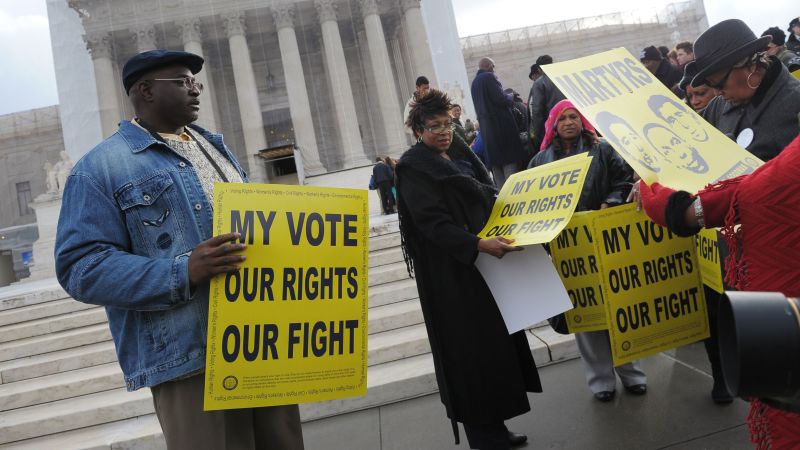A US appellate court decision Monday undercutting the Voting Rights Act of 1965 rejects decades of precedent and appears likely to provoke a confrontation at the US Supreme Court, where the milestone law has been increasingly under attack.
At stake are the voting rights of Blacks, Hispanics and other racial minorities that have been vindicated under a section of the VRA prohibiting discrimination based on race. Section 2 has helped ensure that states draw legislative and congressional districts fairly and that minority voters have an opportunity to elect candidates of their choice.
The Supreme Court – as recently as June – has reaffirmed Section 2. But US appellate judge David Stras, the author of the majority opinion in Monday’s case from Arkansas, observed that Justices Clarence Thomas and Neil Gorsuch have called a key provision of the law into question. His ruling Monday could ultimately gut the law’s protections.
Monday’s appellate court ruling – essentially getting out ahead of the high court – seems certain to instigate a new voting-rights showdown as the nation heads into a presidential election cycle.
The decision is the latest example of former President Donald Trump’s influence over the federal judiciary. Stras, one of Trump’s first appellate court appointees, defied Supreme Court precedent to bolster a conservative interpretation of the law backed by Thomas and Gorsuch, who was Trump’s first Supreme Court appointee.
In Monday’s groundbreaking decision, the 2-to-1 panel of the 8th US Circuit Court of Appeals ruled that private plaintiffs, such as the NAACP Legal Defense Fund or American Civil Liberties Union, have no right to bring litigation on behalf of voters under Section 2. Stras was joined in the majority by Circuit Judge Raymond Gruender, an appointee of former President George W. Bush.
Citing Thomas and Gorsuch, Stras said it has been an “open question” as to how far the law goes. Yet that notion has never drawn as Supreme Court majority.
“For much of the last half-century,” Stras, a former Thomas law clerk, acknowledged, “courts have assumed that Section 2 is privately enforceable.”
But, he added, “A deeper look has revealed that this assumption rests on flimsy footing…”
The decision swept back the history of the legislation and longstanding court interpretations, saying Congress had failed to explicitly detail that private parties could challenge VRA violations. Only the US attorney general has that explicit right, the ruling said.
The dissenting judge countered that a foundational principle of American law is that “where there is a legal right, there is also a legal remedy.” Judge Lavenski Smith, an appointee of former President George W. Bush, added that Congress never intended enforcement of the law – “so foundational to self-government” – to be left only to the federal government.
The justices on the contemporary court have been deeply divided over the reach of the act passed at the height of the Civil Rights movement and only after the March 1965 “Bloody Sunday” attacks on marchers on the Edmund Pettus Bridge in Alabama.
The high court, dominated by conservative jurists, has over the past decade curtailed federal voting protections, giving states more latitude for redistricting and other electoral practices.
But last June, a 5-4 majority reinforced the act’s protections against discriminatory voting lines by invalidating an Alabama map found to have diluted Black voting power. The Alabama legislature had packed much of the state’s African American population into one district and divided the rest among other districts.
Chief Justice John Roberts, who wrote for the slim cross-ideological majority, said Alabama’s arguments flew in the face of precedent. “The heart of these cases,” he wrote, “is not about the law as it exists. It is about Alabama’s attempt to remake our Section 2 jurisprudence anew.”
Thomas, one of the dissenters in that case of Allen v. Milligan, specifically noted at the time: “The Court does not address whether Section 2 contains a private right of action.” Only Gorsuch joined that portion of Thomas’ dissenting opinion, which echoed a point Gorsuch made two years earlier that Thomas signed on to.
Ruling against the Arkansas State Conference NAACP, which had contended the state diminished Black voting power in redistricting, Stras said neither the text nor structure of the VRA gives private plaintiffs a clear right to sue under Section 2.
“If the 1965 Congress clearly intended to create a private right of action, then why not say so in the statute?” he wrote.
Referring to other voting-rights advocates that had joined the state NAACP, he added, “The advocacy groups argue that courts have been adjudicating Section 2 claims brought by private plaintiffs for years, so they must be available. But assuming their existence, and even discussing them, is different from actually deciding that a private right of action exists.”
That contradicts longstanding Supreme Court and lower federal court interpretations of the law, Chief Judge Smith wrote in his dissent.
“Rights so foundational to self-government and citizenship should not depend solely on the discretion or availability of the government’s agents for protection,” Smith said, citing research showing that “over the past forty years, there have been at least 182 successful Section 2 cases; only 15 were brought solely by the Attorney General.”
Smith contended the 8th Circuit majority should have left resolution of whether Section 2 can be invoked by private plaintiffs to the justices – rather than trying to “predict the Supreme Court’s future decisions.”
Read the full article here





